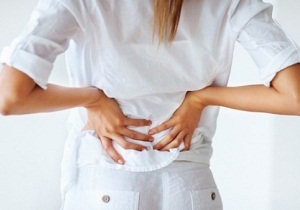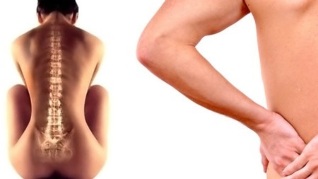If we are to believe the statistics, 70-80% of the population of our country at least once in his life faced with back pain in the lumbar, or, speaking a medical language, pain in the lower back. Its prevalence in the Uk is 59%, in Denmark — 70%, in Finland — 75%. Of all of the issued "hospital" in our country one third of the falls on the cases of pain in the back.

The causes of back pain can be very diverse — from the psychogenic factors of metastasis of the cancer disease. Fortunately, severe pathology of the falls no more than 5% of cases of pain in the lower back, the main reason — a strain or spasm of the muscles, and also other problems of the musculoskeletal system.
Types of back pain in the lumbar
Pain in the back, as well as in any other institution, is diverse. More often it is the character of the pain — the first sign that your doctor may make an assumption about the nature of the disease.
According to the origin of back pain can be:
- primary — caused by chronic functional or dystrophic changes in the tissues of the spine and muscles, sometimes with involvement of the surrounding structures — the nerve roots of the spinal nerves.
- secondary — caused by trauma, inflammation, arthritis or arthrosis of the intervertebral joints, damage to internal organs.
Duration of pain can be:
- acute — arises as a result of new damage or newly occurred of the defective condition, closely related to it, lasts up to 6 weeks;
- subacute — lasts 6-12 weeks;
- chronic — lasting longer than 12 weeks.
Typical clinical manifestations will depend on the source of the pain.
Muscle-tonic and other syndromes of pain
Hypothermia, constant uncomfortable posture at work or rest, improper movement patterns, degenerative disease of the spine, which change the height and elasticity of intervertebral discs, which leads to the fact that the load on the muscles, it is divided unevenly. Some of them are constantly overloaded with what is, on the contrary, do not get the required load. As a result, in the individual muscles begins to cramp, causing pain. Appear the so-called trigger point, impact on the which strengthens the cramps and soreness. The characteristic features of the pain:
- clearly demarcated plot of land (local pain);
- felt deep in the muscle layer;
- in the muscle of the detectable taut stretch or tension bar, in which are detected in particular painful points;
- when exposed to these points, pain is greatly enhanced, makes the patient flinch (flag hopping);
- restrictions on mobility;
- if you can stretch the muscle reduces the pain.
Exactly for this kind of pain, good effect of the ointment that warm or favorite accessories. The truth is, that the effect of them is short-lived, because the cause which causes a spasm of the muscles, they do not eliminate. A more reliable method is the injection of the anesthetic drug directly in the trigger point, as well as kinesiotherapy, physiotherapy, manual therapy.
Compression radiculopathy
It is caused by compression or stretching of the roots of the spinal nerves due to disc herniation or reduction of its height, and as a result, the distance between the vertebrae. Such pain is often manifested as "surface", expanding first on the skin, than in the depth of the tissues. It is significantly amplified when sneezing, coughing, the load on the spine. Exactly the kind of pain manifests as a classic "lumbago", it gives on the go the nerve root.
Spinal stenosis
Arises as a result of disc herniation, extrusion (extrusion) of the spinal canal or the appearance of sequestrations — exfoliated parts of the disk. One way or another squeezed education under the name "horse tail" — the roots of most of the lower spinal nerves, Innervate the lower extremities. Pain when it spreads along the course of the nerve root, from the restraint to stop, appear and at rest and during walking, is amplified when the extension of the spine and decreases when tilted forward.
Special syndrome
Called the pathology of the small intervertebral (facet) joints. The pain may be local, but also radiation (back) to the groin, coccyx, on the posterior side of the thigh. Is amplified when the slopes and the rotation of the lower part of the back.
All these kinds of pain syndrome appears acutely, sometimes the patient may even say, in what exactly the day and after the impact (something picked up, not turned, and other). The pains are aggravated towards evening and after physical exertion, which diminishes after rest. More often a similar kind of pain is typical for people of middle age and the elderly.

Inflammatory pain
Is caused by inflammatory damage to the joints of the spine — the various kinds of arthritis: rheumatoid, reiter's disease, ankylosing spondylitis, and so on Inflammatory pain often occurs in relatively young people, develops gradually. It is at its maximum at the beginning of the day and dropping into the evening, or after physical exertion. It is often accompanied by morning stiffness.
Other possible causes of pain in the lower back — the pathology of internal organs, for example kidney disease or inflammation of appendages in women. Because many diseases can manifest themselves in a similar way, at least in terms of pain syndrome, it is better to deal with the diagnosis for himself, and seek medical help.
Immediate expert advice should be in case, if:
- the pain appeared after an injury, especially in women aged;
- in the past there cancer disease;
- the pain is accompanied by an increase in temperature;
- suddenly and for no apparent reason reduces the weight;
- changing the walk or taken the legs;
- appear to difficulties in urination and bowel movements.
These symptoms may be a manifestation of the most severe diseases that require immediate treatment.
Diagnostic pathology
When pain in the back and the lumbar region of your doctor, first of all it is necessary to exclude life-threatening conditions — fortunately, they are relatively rare.
General and biochemical analysis of blood allow to identify inflammatory changes, to discover the elevated levels of calcium, characteristic of metastases of malignant tumors to bone structures, changes in the number of blood cells in the myeloma disease and so on. Men aged may prescribe an analysis on the prostate-specific antigen to exclude a possible prostate cancer.
The Xray examination will reveal changes in the height of the intervertebral disc, it is possible osteophytes — outgrowths of bone tissue caused by an incorrectly distributed load on the vertebrae, the change in shape of the vertebrae.
Computed tomography and MRI will show bulging of the intervertebral disc, calcification (land calcification), spinal stenosis.
Today on the alternation of these two studies gradually comes ULTRASOUND of the spine, which allows to detect similar changes, without exposing the patient to excessive radiation burden.
The necessary consultation of the neurologist, on the testimony of the chiropractor.
After a complete examination it becomes clear treatment strategy. As usual, cope with the pain in the lumbar region of the possible treatment methods, surgery is indicated relatively rarely.
Treatment the treatment of pain in the lumbar region of the back
In 95% of cases, in the patient there is no reason for concern — usually back pain does not constitute a risk to health and can be treatable. Myofascial syndrome fixed faster, for the removal of the root of the pain may take several months. One way or another, in most cases the need for drug therapy. Use non-steroidal anti-inflammatory agents (NSAIDS) to alleviate pain and reduce swelling, medicines for maintaining a prolapse of the cartilage. Sometimes, to reduce pain and swelling prescribe and hormonal drugs — it acts faster non-steroidal anti-inflammatory is administered in the form of the blockade and of dropper under the supervision of a physician.
Drugs can be in the form of ointments and gels — this method of treatment of pain in the lower back of popular advertising videos. But as a method of introduction into the body of the active substance by external means — is ineffective, that it is possible to predict, because a large part of the funds also penetrates through the skin.
Other popular method — the oral intake of medicines, or, simply put, tablets and capsules. Drinking a pill is easy, the effect comes quite quickly, usually within half an hour-an hour, but long-term use of drugs can affect the condition of the digestive tract.
So the fastest and most effective way to relieve the pain — injections directly into the muscle or area of the affected root, the so-called blockade. Their only drawback — the hard requirement for high qualifications of the doctor who will perform this manipulation.
Non-drug therapy
As usual, the medicinal, the treatment is supplemented by non-drug methods. What exactly physiotherapy need, treating physician decides. It can be and a classic massage, or manual therapy, and osteopathic treatments, as well as acupuncture. Gaining popularity and kinesitherapy — special gymnastics in the form of exercise on a special decompression simulators, which help to get rid of tense muscles, create new movement patterns, thus eliminating the cause of back pain.

So the best option therapy for back pain — a combination of medical methods and non-drug approach. This comprehensive work in several directions allows faster to cope with the disease, completely get rid of the pain or to gain a lasting effect.

























